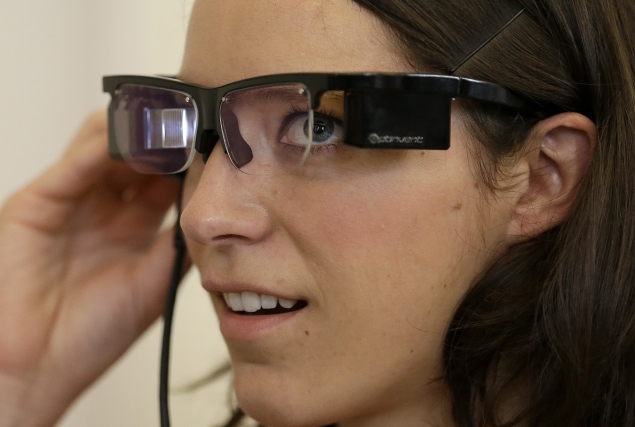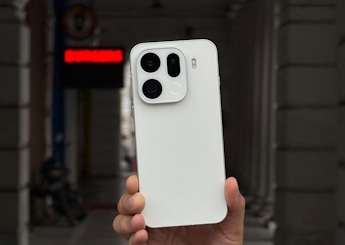- Home
- Others
- Others News
- Wearable technologies to see major leaps by next year
Wearable technologies to see major leaps by next year

"Everyone agrees the race is just beginning, and I think we're going to see some very, very big leaps in just the next year," said tech entrepreneur Manish Chandra at a wearable technology conference and fashion show in San Francisco Monday that was buzzing with hundreds of developers, engineers and designers.
Wearable technologies have long been a sideshow to mainstream laptop and smartphones, but this year Google's glasses and rumors of Apple's iWatch are popularizing the field. Analysts forecast swift growth. Last year the market for wearable technology - encompassing everything from hearing aids to wristband pedometers - totaled almost $9 billion. That should climb to $30 billion by 2018, said analyst Shane Walker at IHS Global Insights.
Humans have been wearing technology for centuries, from strapped-on compasses to pocket watches. The current surging industry is centered in the Silicon Valley and San Francisco Bay area, where mostly smaller startups design their products locally and have them manufactured in Asia to take advantage of cheap labor. Monday's conference was one of several focusing exclusively on wearable technology in recent years.
As wearable technologies proliferate, humans will need to adapt, said Georgia Tech professor Thad Starner. He advises Google on its glasses, which are lightweight frames equipped with a hidden camera and tiny display that responds to voice commands. Starner has worn his for several years.
"We're talking about paradigm changing devices," said Starner. "Capabilities that people haven't thought of before."
He said that, unlike computers and tablets that people engage with, wearable computers are designed to be in the background, secondary to the wearer's attention.
"It seems like a paradox, but when you pull the technology closer to your body, there's a seamless interaction, it's more an extension of yourself," he said.
But there are sure to be cultural and social issues. Google Glass - and some emerging competitors - have raised concerns of people who don't want to be surreptitiously videoed or photographed. And what about interacting?
At Monday's conference, attendees slipped on monitors that measured their heart rates and temperatures to reflect whether they really were enjoying a movie, and shot photos through their Google Glasses of Vibease, the world's first wearable vibrator controlled by smartphones, promising long distance intimacy.
"Do you really want a touch screen on the front of your t-shirt? Is it socially acceptable to be poked all over your body for somebody to use your wearable computer?" asked Genevi Dion, who directs a fashion and technology lab at Drexel University.
The answer, for some, is no.
In a newly released survey from Cornerstone OnDemand, 42 percent of workers said they would not be willing to strap on wearable tech for their jobs, with older and more traditional employees more reluctant than their counterparts. The survey polled 1,029 Americans aged 18 and over in August, and had a 3.1 percent margin of error.
And then there's an issue of bandwidth, said Ritch Blasi, a consultant with SVP-Comunicano who researches the wearable technology market. At this point, there simply isn't enough network service to support universal and constant wireless use, he said. But that too will catch up.
"It almost makes you think everyone is going to turn into a cyborg," he said, referring to a fictional, prosthetic-laden high tech comic book superhero.
And will they?
"When you look at the world and everything people are doing?" said Blasi, pausing for a moment. "I think the answer to that is yes."
Get your daily dose of tech news, reviews, and insights, in under 80 characters on Gadgets 360 Turbo. Connect with fellow tech lovers on our Forum. Follow us on X, Facebook, WhatsApp, Threads and Google News for instant updates. Catch all the action on our YouTube channel.
Related Stories
- Samsung Galaxy Unpacked 2025
- ChatGPT
- Redmi Note 14 Pro+
- iPhone 16
- Apple Vision Pro
- Oneplus 12
- OnePlus Nord CE 3 Lite 5G
- iPhone 13
- Xiaomi 14 Pro
- Oppo Find N3
- Tecno Spark Go (2023)
- Realme V30
- Best Phones Under 25000
- Samsung Galaxy S24 Series
- Cryptocurrency
- iQoo 12
- Samsung Galaxy S24 Ultra
- Giottus
- Samsung Galaxy Z Flip 5
- Apple 'Scary Fast'
- Housefull 5
- GoPro Hero 12 Black Review
- Invincible Season 2
- JioGlass
- HD Ready TV
- Laptop Under 50000
- Smartwatch Under 10000
- Latest Mobile Phones
- Compare Phones
- Realme Narzo 90x 5G
- Realme Narzo 90 5G
- Vivo S50 Pro Mini
- Vivo S50
- OPPO Reno 15c
- Redmi Note 15 5G
- Redmi Note 15 Pro 5G
- Redmi Note 15 Pro+ 5G
- Asus ProArt P16
- MacBook Pro 14-inch (M5, 2025)
- OnePlus Pad Go 2
- Poco Pad M1
- Just Corseca Skywatch Pro
- Honor Watch X5
- Acerpure Nitro Z Series 100-inch QLED TV
- Samsung 43 Inch LED Ultra HD (4K) Smart TV (UA43UE81AFULXL)
- Asus ROG Ally
- Nintendo Switch Lite
- Haier 1.6 Ton 5 Star Inverter Split AC (HSU19G-MZAID5BN-INV)
- Haier 1.6 Ton 5 Star Inverter Split AC (HSU19G-MZAIM5BN-INV)

















